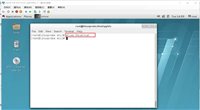目录
ajax(asynchronous javascript and xml)翻译成英文就是“异步javascript和xml”。即用javascript语言与服务器进行异步交互,传输的数据为xml,(现在使用更多的是json数据)。
异步交互:客户端发送一个请求后,无需等待服务器响应结束,就可以发送第二个请求;
局部刷新:浏览器页面局部刷新
局部刷新的意思就是当咱们在博客园注册一个新的博客的时候,当咱们输入用户名后鼠标移开的时候,就发送了一个请求,去验证这个用户是否存在,如果存在,则通知用户该用户名已经被注册了。

让我们使用pycharm重新创建一个项目,项目名为ajax_demo,应用名为app01。
# url控制器
from django.contrib import admin
from django.urls import path
from app01 import views
urlpatterns = [
path('admin/', admin.site.urls),
path('index/', views.index),
path('test_ajax/', views.test_ajax),
]
那么当我们需要有对应的视图函数 index和test_ajax:
# app01-->views.py
from django.shortcuts import render,httpresponse
# create your views here.
def index(request):
return render(request, '')
def test_ajax(request):
return httpresponse('hello!world!')
在这里匹配了相应的视图然后返回了一个html页面:
#
<!doctype html>
<html lang="en">
<head>
<meta charset="utf-8">
<title>title</title>
<script src="http://code.jquery.com/jquery-2.1.1.min.js"></script>
</head>
<body>
<h3>功能1:发送ajax请求</h3>
<p class="content"></p> //这里的内容是空的
<button class="btn">ajax</button>
<script>
$('.btn').click(function(){
$.ajax({
url:'/test_ajax/',
type:'get',
success:function(data){
$('.content').html(data)
}
})
})
</script>
</body>
</html>
这句话的意思是,当咱们点击button按钮的时候,触发了点击动作,然后发送了一个ajax请求,让我们先看看此时是什么样子的:

当我们点击了按钮的时候,就发送了一个ajax请求:

此时一个简单的ajax请求就发送完成了。
首先咱们的中进行布局:
#
<h3>功能2:利用ajax实现的计算器</h3>
<input type="text" class="num1">+<input type="text" class="num2">=<input type="text" id="sum"><button class="cal">计算</button>
$('.cal').click(function(){
$.ajax({
url:'/cal/',
type:'post',
data:{
'n1':$('.num1').val(),
'n2':$('.num2').val(),
},
success:function(data){
console.log(data);
$('#sum').val(data);
}
})
})
然后咱们拿到了n1和n2的值,通过请求url发送给相应的视图然后进行数据处理,最后拿到结果再返回给这个ajax。
# views.py
def cal(request):
print(request.post)
n1 = int(request.post.get('n1'))
n2 = int(request.post.get('n2'))
sum = n1+n2
return httpresponse(sum)
此时的url控制器需要新添加一条:
path('cal/', views.cal),
其次是配置文件settings中的这一行需要注释掉:
# 'django.middleware.csrf.csrfviewmiddleware',
此时再查看结果:

首先咱们要开一个路由,当用户在浏览器输入http://127.0.0.1/login_btn/的时候,就匹配导对应的视图,所以:
# url控制器
from django.contrib import admin
from django.urls import path
from app01 import views
urlpatterns = [
path('admin/', admin.site.urls),
path('index/', views.index),
path('test_ajax/', views.test_ajax),
path('cal/', views.cal),
path('login/', views.login),
path('login_btn/', views.login_btn),
]
# login_btn函数
def login_btn(request):
return render(request, 'login_btn.html')
然后返回了这个html页面:
<!doctype html>
<html lang="en">
<head>
<meta charset="utf-8">
<title>title</title>
<script src="http://code.jquery.com/jquery-2.1.1.min.js"></script>
</head>
<body>
<h3>利用ajax实现登陆认证</h3>
<form action="">
用户名 <input type="text" class="user">
密码 <input type="password" class="pwd">
<input type="button" value="submit" class="login_btn">
<span class="error"></span>
</form>
<script>
$('.login_btn').click(function(){
$.ajax({
url:'/login/',
type:'post',
data:{
'user':$('.user').val(),
'pwd':$('.pwd').val(),
},
success:function(data){
//此时需要进行转换
console.log(typeof(data));
var data = json.parse(data)
console.log(typeof(data));
if (data.user){
location.href = 'http://www.baidu.com'
}else{
$('.error').html(data.msg).css({'color':'red'})
}
}
})
})
</script>
</body>
</html>
最后ajax将请求提交到了/login/中,然后进行匹配视图,然后就开始执行对应代码:
def login(request):
# print(request.post)
user = request.post.get('user')
pwd = request.post.get('pwd')
from .models import user
user = user.objects.filter(user=user, pwd=pwd).first()
ret = {
'user': none,
'msg': none
}
if user:
ret['user'] = user.user
else:
ret['msg'] = 'username or password is wrong!'
import json
return httpresponse(json.dumps(ret))
首先打开浏览器,输入错误的用户名和密码:

然后开始输入正确的用户名和密码,就会直接跳转到百度的首页了。
# urls.py
path('file_put/', views.file_put),
# views.py
# 文件的上传
def file_put(request):
if request.method == 'post':
print(request.post)
return render(request, 'file_put.html')
# file_put.html
<!doctype html>
<html lang="en">
<head>
<meta charset="utf-8">
<title>文件上传</title>
</head>
<body>
<h3>基于form表单实现的文件上传</h3>
<form action="" method="post" enctype="multipart/form-data">
用户名 <input type="text" name="user">
头像 <input type="file" name="avatar">
<input type="submit">
</form>
</body>
</html>
此时咱们输入完用户名和选中完图片后,点击提交咱们查看下打印的信息。


那么是我们的图片没有上传过来吗?当然不是的,是因为上传的图片就不在这里面。让我们在views.py中执行这个代码:
print(request.files)
看到的是这个样子:

那么此时我们就可以确定,这个文件是上传过来了,存放在request.files中,那么咱们使用request.files.get就可以把这个图片对象拿到了。
# views.py
def file_put(request):
if request.method == 'post':
print(request.post) #
# print(request.body)
print(request.files) # 图片信息
# 将文件给取出来
img_obj = request.files.get('avatar')
with open(img_obj.name, 'wb') as f:
for line in img_obj:
f.write(line)
return httpresponse('ok!')
return render(request, 'file_put.html')
那么此时直接上传的话,那么就会在当前项目下展示这张照片。
首先我们需要新开一个url或者将之前的注释掉:
# urls.py
path('file_put/', views.file_put),
ajax提交文件的方式同样使用form表单,但是不需要给input设置name属性,只需要设置class或者id就可以了:
# file_put.html
<form action="" method="post">
用户名 <input type="text" id="user">
头像 <input type="file" id="avatar" >
<input type="button" class="btn" value="ajax">
</form>
那么咱们需要给btn设置点击click动作:
$('.btn').click(function(){
//涉及到文件上传 需要创建formdata对象
var formdata = new formdata();
formdata.append('user',$('#user').val());
formdata.append('avatar',$('#avatar')[0].files[0]);
$.ajax({
url:'',
type:'post',
contenttype:false, // 交给formdata处理编码
processdata:false, //对数据是否进行预处理 如果不做预处理的话 就不做任何编码了
data:formdata,
success:function(data){
console.log(data)
}
})
})
最后在试图函数中进行文件保存操作:
def file_put(request):
if request.method == "post":
print("body", request.body) # 请求报文中的请求体 json
print("post", request.post) # if contenttype==urlencoded ,request.post才有数据
print('files', request.files)
file_obj=request.files.get("avatar")
with open(file_obj.name,"wb") as f:
for line in file_obj:
f.write(line)
return httpresponse("ok")
return render(request, "file_put.html")
在咱们刚刚的form表单的文件上传和ajax文件上传的时候,都涉及到一个请求头的东西,这个东西是什么呢?这个东西决定着服务器会按照哪种编码格式给你解码,当你默认不写的时候,此时的请求头是:application/x-www-form-urlencoded,当你想发送文件类的东西,此时的请求头应该是:form-data......
当服务器收到客户端发送过来的请求时,首先就会去查看请求头,判断你的请求头是什么,然后进行解码。
让我们分别看下这几个请求头:
application/x-www-form-urlencoded:表单数据编码为键值对,&分隔,可以当成咱们的get请求中?后面的数据,让我们发送一个庶几乎看看:
<form action="" method="post"> 用户名 <input type="text" name="user"> 密码 <input type="password" name="pwd"> <input type="submit" value="submit"> </form>
那么我们需要一个视图函数还进行处理:
def file_put(request):
if request.method == "post":
print("body", request.body) # 请求报文中的请求体 json
print("post", request.post) # if contenttype==urlencoded ,request.post才有数据
return httpresponse("ok")
return render(request, "file_put.html")
当我们在浏览器输入admin和123的时候,让我们来看下打印的结果是什么:

我们刚刚说过,当我们请求头什么都不写的话,那么就是默认的x-www-form-urlencoded,当请求头是这种的话,此时我们打印request.post是有值的,也就这一种请求方式request.post才有值。

让我们现在发送一个json的数据
<!doctype html>
<html lang="en">
<head>
<meta charset="utf-8">
<title>title</title>
<script src="http://code.jquery.com/jquery-2.1.1.min.js"></script>
</head>
<body>
<form action="" method="post">
用户名 <input type="text" class="user">
密码 <input type="password" class="pwd">
<input type="button" value="submit" class="btn">
</form>
<script>
$('.btn').click(function(){
$.ajax({
url:'',
type:'post',
data:json.stringify({
a:1,
b:2
}),
success:function(data){
console.log(data)
}
})
})
</script>
</body>
</html>
视图函数中是这样的:
def send_json(request):
if request.method == 'post':
print('body', request.body)
print('post', request.post)
print('files', request.files)
return httpresponse('ok!')
return render(request, 'send_json.html')
当我们发送数据的时候,通过解码收到的就是这样的数据:

就和我们刚刚说的一样,当请求头是x-www-form-urlencoded的时候,request.post才会有数据,其他的就没有。
如对本文有疑问, 点击进行留言回复!!


linux下文本编辑器vim的使用方法(复制、粘贴、替换、行号、撤销、多文件操作)





网友评论